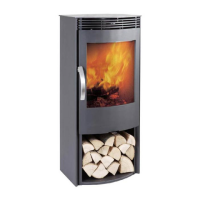When you are lighting it is important that the fire takes hold and that the temperature rises
quickly. E.g. light with dry brushwood or kindling wood.
Only fire with clean and dry wood in your wood-burning stove.
When you hit two pieces of dry wood against each other it makes a ’crisp’ or ’dry’ sound. It
is a good idea to bring in the firewood in good time so the surface moisture evaporates
before it goes into the wood-burning stove.
Do not put too much firewood into the wood-burning stove at once. With small amounts it is
easier for the fire to take hold and reach a high temperature quickly. Put more firewood into
the wood-burning stove a little at a time and remember to turn up the air each time until
there is a nice fire again.
Air is important to ensure good combustion. As long as there are yellow flames you do not
need to turn up the air supply. A good combustion of the exhaust gasses requires a high
temperature and sufficient air. If you turn it down too quickly the unburned gasses will rise
up through the chimney and leave soot. It is a bad idea to let the wood-burning stove burn
all night with a minimum of air. The chimney may soot up and poor combustion leads to
more unhealthy smoke.
If you are unsure whether your wood-burning stove bothers anyone, then go outside and
see if there is a lot of smoke. If you think it smells badly, then your neighbour probably
thinks so too.
Technical specifications
Height: 950 mm
Width: 458 mm
Depth: 414 mm
Rear exit: 788 mm
Exhaust branch: Ø 150 mm
Weight: 120 kg
Average values for testing
Exhaust gas temperature: 324º C
Exhaust gas mass flow: 4.4 g/s
Effect degree: 79.6%
Nominal effect: 5 kW
Uptake: 0.12 mbar/12 Pa

